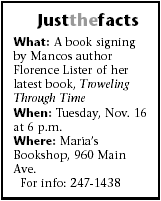|
By Ken Wright
This is a really good book.
I start by saying that right up front, because, unless you're already an archaeology
buff or scholar, there just aren't many engaging, entertaining books out there
about archaeology. Given that, a book about the history of archaeology seems
doomed to life as a paperweight.
But Florence Lister has pulled off both, with flair.
Troweling Through Time
is a history of the first 100 years of archaeology in what is known in the scholarly world as the "Mesa Verde Province" - the area of the Colorado Plateau north of the San Juan River, from the San Juans west to the Colorado River. And the 84-year-old Lister knows both this region and its archaeology intimately. She and her husband, Robert (who passed away in 1990), have been key actors in Southwestern archaeology since the 1940s. Mr. Lister was a professor at the University of Colorado and directed the CU Field School at Mesa Verde National Park, while Mrs. Lister directed the Ceramic Studies program at Mesa Verde. Mrs. Lister also has authored innumerable monographs and nearly a dozen books, both on her own and in collaboration with her husband.
Given this experience, in both fieldwork and scholarship, Lister knows the history of which she writes - the story of those who explore the stories of the area's ancient residents.
It shows in
Troweling Through Time
. The book is certainly first and foremost a historical text - detailed, chronological, footnoted and indexed. But in execution, it is a
story
, beautifully and lovingly told. And what will probably come as a surprise to those who think they know the Four Corners area, it is a story with a lot to teach, about both the ancient native cultures and the Euroamericans who came later to sift through their remains.
 In Lister's telling, it's also an intriguing tale, full of characters, adventures, discoveries, misadventures and an ever-present sense of a place. In Lister's telling, it's also an intriguing tale, full of characters, adventures, discoveries, misadventures and an ever-present sense of a place.
The story begins in 1849, when a Corps of Topographical Engineers troop, exploring the region just acquired from Mexico, wandered through what Lister calls "the richest archaeological zone north of central Mexico." A first lieutenant with the troop attributed the area's ruins to the Toltecs of Mexico, a mistake that would haunt archaeology in the Four Corners for decades (as in "Aztec Ruins," in Aztec, N.M.).
From these first discoveries, Lister moves on to the stories of those who would later make discoveries of more hidden sites, those who would exploit these findings with both tourism and the selling of artifacts, those who would bring in science to understand the culture that created the artifacts, and those who would protect these amazing resources for future study and enjoyment.

|
|
Ute workers excavate Tree House, a ruin located in Lion Canyon, during the summer of 1972.
|
From these first discoveries, Lister moves on to the stories of those who would later make discoveries of more hidden sites, those who would exploit these findings with both tourism and the selling of artifacts, those who would bring in science to understand the culture that created the artifacts, and those who would protect these amazing resources for future study and enjoyment.
This proves to be a parade of interesting characters and intriguing adventures.
Mancos, Lister's own hometown, comes to be a center for exploration of the Mesa Verde area's archaeology. Although the Wetherills - the cowboy family that made Mesa Verde famous - are the best-known Mancos residents, Lister begins the Mancos story with Virginia McClurg. A writer from New York City, McClurg became the first white woman to visit the area after she saw an illustrated article about the discoveries of ruins in Mancos Canyon. She then got her own assignment from the
New York Daily Graphic
to write about the area.
According to Lister, McClurg was "obese, fond of large, feathered hats, and given to heavy use of cosmetics." She also wasn't welcome: Mesa Verde had recently been made part of the Ute Reservation, and the Utes weren't in a mood for tourists. Given this, the commander at Fort Lewis, in the La Plata Valley, wasn't too keen on tourists, either. He finally relented, though, under McClurg's persistence and had troops escort McClurg on a three-week adventure-filled journey down Mancos Canyon and up into Mesa Verde.
As a result of her explorations, McClurg later became a leader in the movement to get the region's archaeological resources protected. This, too, leads to one of the many little-known stories of the area that Lister chronicles. "As the twentieth century dawned, men pillaged many of the antiquities of the northern San Juan mesa and canyon country," writes Lister. "Women launched a campaign to stop them."
Like any good story, people like this - alive, quirky, unexpected, unpredictable - populate
Troweling Through Time
. But also, like any good history, Lister has laced her text with easy-to-comprehend explanations about the lives and environment of the ancient people who left behind a fascinating and now world-renowned record of their culture.
And like any good storyteller (a term not always associated with historians or scientists), Lister has infused her text with a sense of love for both the people and the place that shaped the people, both ancient and modern, who have shared the Four Corners landscape over the past thousand years.
Lister will be on hand at Maria's Bookshop to discuss and sign copies of Troweling Through Time on Nov. 16.
|